Here are some photos of side trips taken while on excursions in Greece last April. The Turkish carpet consortium alone takes in a small fortune from tourists, I don't begrudge them at all. For years, in San Juan, PR, I tried to pry money out of cruise-ship tourists (Carnival was the toughest) during art shows and street fairs. That experience has affected my overall feelings towards 'bargaining' with artists to get a financial break you need far less than the artist.
This is the Carpetarium, an artist's cooperative sponsored by the Turkish government, in Selcuk. We were told that each carpet is woven using double-knots and can take an individual weaver months up to years to complete a single carpet. They weave at home and don't trade-off weavers, to maintain a consistent appearance.
The cooperative is a destination for most if not all cruise line excursions to Ephesus and Kusadasi. We were offered an opportunity to try the knotting but no one raised their hand. The women never stopped their work. After all that double-knotting you can imagine how hard it is on their hands, year after year; and their working longevity is relatively short-lived. I pity young people texting incessantly. I never thought about arthritis, either. Look at this colorful quilt interpretation!

I was fascinated by the woman pulling silk from the cocoons (r). Silkworm cocoons first soak in hot water, then this lady uses a whisk broom to gently grab the silk to be wound, you have to look closely to see the silk. Maybe this is what they do once their knotting-days end. I missed the part about getting wound on the roll, and surely there was mention of the strength of silk, that's amazing, too. (Pound for pound, spider silk is stronger than steel.) They hand out cocoons to the kids, one proudly showed me.
Not unlike a maze, we were led through the simple building with carpet-lined walls until we reached a large room with benches lining the walls. Our tour group settled in while the host pointed around the room, asking in turn from whence we came. I was the only one from Oregon.
Next came the show. One after another, gorgeous carpets were unrolled and piled one upon another. These are demos; I've seen them online in other's photos. We were asked our favorites, just as our home towns were questioned. Nothing had price tags and the host never said how much they were; only that orders would arrive 6-8 weeks from purchase, shipping included. I assumed it was a case of,
"If you have to ask the price, you can't afford it."
I was right. Only on the bus did I learn the carpets averaged $7-10,000 US, with some proudly proclaiming they got better prices for buying two or three, imagine.
In any event, it didn't cost to look; so while most everyone was busy selecting their purchases, I took the time to admire the framed, intricate designs which looked more like paintings than carpets.
The nice-looking host came over to chat, but I quickly let him off the hook by explaining I, too, am an artist, so basically he's barking up the wrong tree. Undeterred, he remained and we discussed being an artist in any country, which I thought was nice of him.
I hate to leave a gallery or shop empty-handed, particularly an artist's cooperative. Luckily there were other booths selling more affordable trinkets, so I was able to take home a few teeny ceramic bowls from another artist in the cooperative.
They served a tasty buffet at the end of the tour, can't beat that. One tour bus was being loaded as we hit the picnic tables, and as I munched I considered the impressive timing and efficiency of the tour.

I sat behind the driver on the way back to the ship; next to the three-carpet woman, from whom I obtained said details.(Read about the
Ephesus tour prior to this stop.)
The following two sidetrips on Crete followed the
Knossos tour. Completed in record time, we rode through the Cretan countryside to a pottery shop of grand proportions, another typical stop on Greek excursions, most likely.
The Potter stood patiently as we entered the room, then slapped down a ball of clay and went to work while we all oohed and aahed. He was fast enough to create two pieces while we watched.
Stunned by the gift shop, I selected more magnets plus one of those teeny pitchurs you see along the wall. I even managed to get it home in one piece.
We all tred carefully through the maze. I clutched my day-pack for dear life lest I cause a Domino effect by mistake (I have depth-perception difficulty.)
Here's a pretty shot of the outside of the place.
The huge urns were particularly eye-catching. I wondered how they were made, nobody's got hands that large.
They're created in sections, then carefully assembled and fired in a separate furnace outside, takes a couple guys to carry them.
I couldn't decide whether I liked the plain or painted better. It was a short visit, maybe an hour, and then we were herded back on to the bus. I definitely prefer the freedom of travelling without an organized tour, but I was seeing a good many things in a short period of time, can't complain about that.
The bus continued on to the tiny town of Myrtia, famous as the birthplace of Nikos Kazantzakis, author of Zorba the Greek. The bus slowed on the narrow streets until it stopped next to nothing.
I love streets like this.
Finally, something I've heard of...loved Anthony Quinn in the movie. We were led to the plaza, look at this wonderful tree, and the phone booth.
We all stood around for a few moments, then people started heading for a little Colmado for sodas and snacks for the bus ride home. I continued exploring the plaza.
An interesting bronze sculpture took center stage. If I recall, the piece represents Kazantzakis's life trajectory, as he was apparently quite a traveller. There's undoubtedly more symbolism known only to the artist. I liked it, as did this little girl.

The guide couldn't identify this sculpture just off the plaza and I couldn't find it online, so if anyone knows I'd love a answer in the comment section below, thanks.
It's evident the isolated town's draw is Kazantzakis. The season had still not begun so not everything was open, but I liked the deserted streets.
The bus driver parked elsewhere so we walked through more side streets. A couple of us stopped to shoot another mural, loved the monochronistic simplicity.

After that brief stop we headed back to Hereklion, the capitol, where we were free to wander for the rest of the afternoon, or 1/2 hour to catch the bus ride to the ship's dock, thataway.
The guide pointed back up the pedestrian street we'd strolled down towards the Morosini Lions Fountain, here's some details:
"Handakas, as the town was called in medieval times, always faced water shortages. When a number of attempts to solve this problem failed, the Venetian noble Francesco Morosini decided to construct a 15-kilometer-long aqueduct that would carry water from Mount Juktas to the town.
"Underneath the fountain, there are seven different levels made of stone, which made it possible for the water to gush from the mouth of each of the four lions that flanked the eight basins. The shape of the fountain was function-oriented, allowing as many as forty people to get water at the same time." From
Greeka.
"Where, again?" I asked the guide, since I didn't have the inclination to shop and stop for lunch. She said the next street ran perpendicular and would take me to the same place, which of course I opted to do.
Look at these streets, compared with the crowds shown on TV these days, with locals shouting, "Tourists Go Home." I definitely recommend travelling to Greece in April, pre-Easter for sure.
I took a right towards two interesting-looking buildings, I liked their contrast; then turned left towards the meeting point.
Except the guide's definition of 'perpendicular' and mine did not match, and I became disoriented. I found some parked buses and recognized the sign on one of them as belonging to one of the Toccata groups; but it wasn't MY bus so the driver wouldn't let me get on and wait. I finally spotted my bus on the other side of a busy traffic circle, but the light changed and he turned away from me. I tried to hustle but soon lost sight of it, and by this point I was all turned around
DAMN, why didn't I study
How to Read Greek in 5 Days better? Wait, gal, don't panic.
All you have to do is head for the water, that's the nice thing about being on an island. I was tired of walking but had no choice. It couldn't be far, and I had plenty of time.
I eventually landed here at the Koules Fortress, built by the Republic of Venice in the early 16th century. I spotted several cruise ships in the harbor, and followed some passengers I recognized the rest of the way home.
Up next: Santorini at Last
To read from the beginning: Athens and the Acropolis




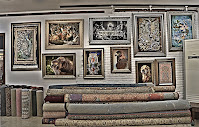

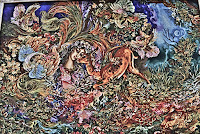

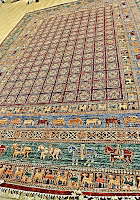



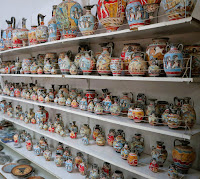















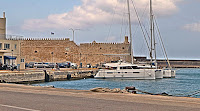
Thanks for the trip down memory lane! Some who bought the carpets have received them and they are very pleased! No buyers remorse:) I was so glad I had seen the gals making the rugs in person! that's a lot of knots, and I am sure MY arthritic fingers would have "thrown in the towel" after about 15 minutes!!!
ReplyDeleteYes'm!
ReplyDeleteLove this! I've gotten lost alone in a few major cities, and at first, the blood would drain from my face and I'd get a sinking feeling like a lost child looking for her mother. But then I'd find my way and at the end, the episode would be one of the highlights of a trip because I'd discovered that I COULD manage in a strange place even if I didn't speak the language. It's actually an empowering feeling that spills over into other unforseen experiences in life!
ReplyDeleteThanks for that, and you're absolutely right about feeling more empowered. The entire trip was making me feel more so.
Delete